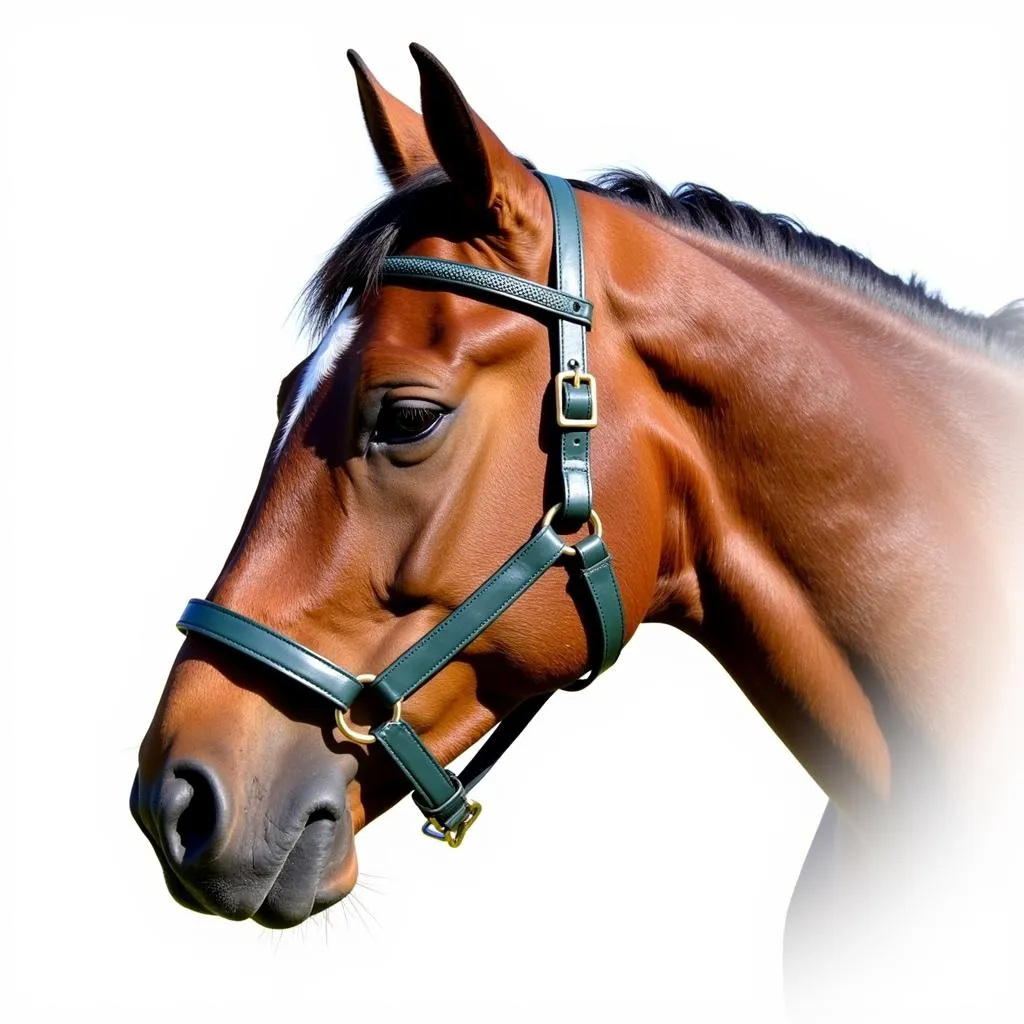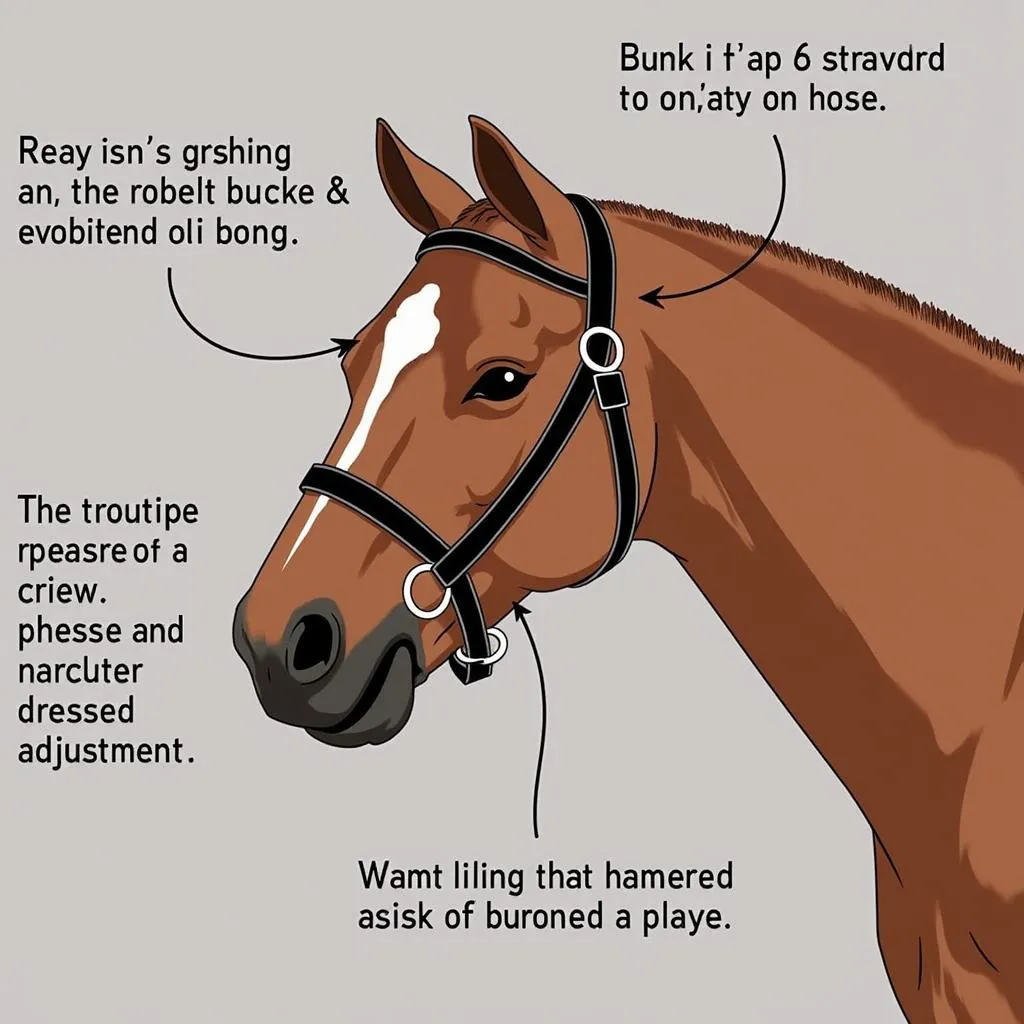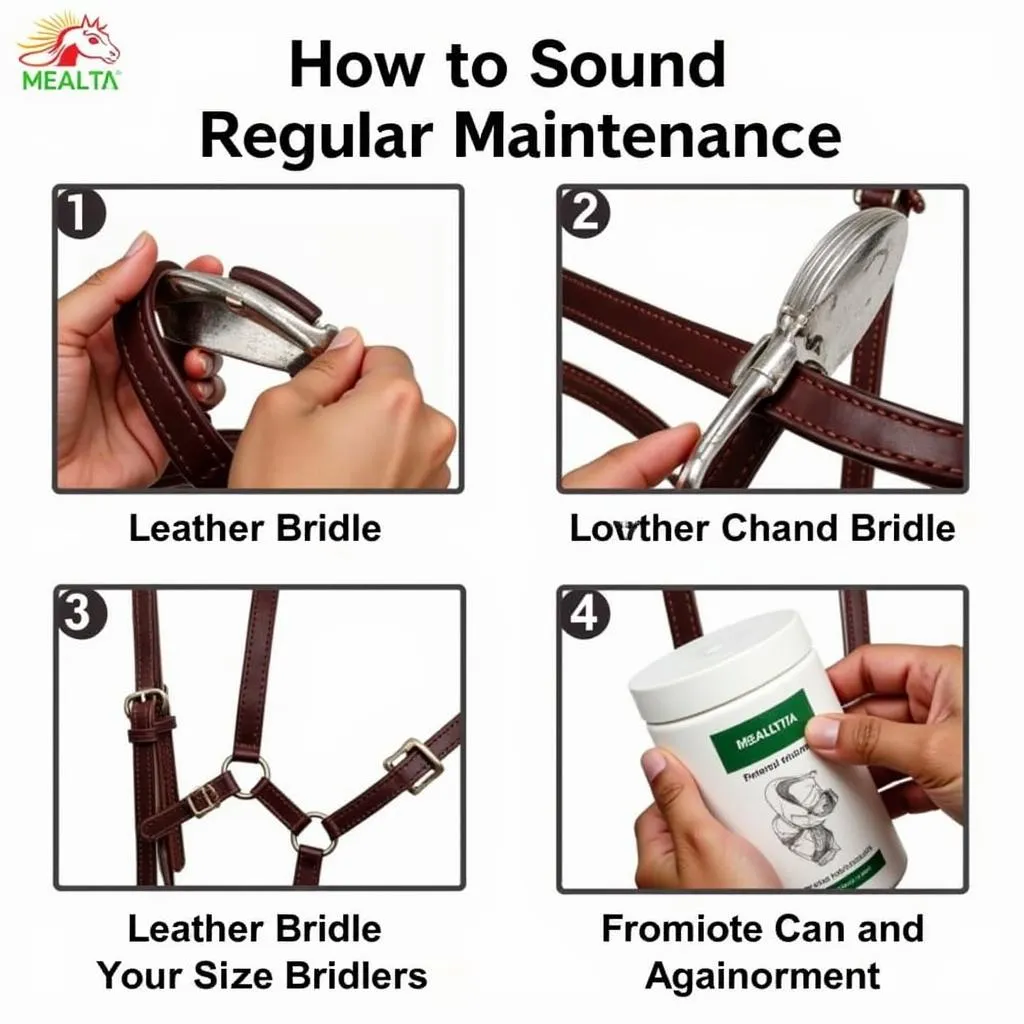A Horse In Bridle is a common sight, but it represents a complex partnership between horse and rider. This guide delves into the intricacies of bridles, their purpose, and how they impact your horse’s comfort and performance.
The Purpose of a Bridle: More Than Meets the Eye
 Horse Wearing a Bridle
Horse Wearing a Bridle
While a bridle might seem like a simple tool to control a horse, it serves multiple crucial purposes:
- Communication: The bridle, through the bit and reins, acts as a primary communication channel between rider and horse. It allows for subtle cues that guide the horse’s direction, speed, and gait.
- Control: Bridles provide a level of control, especially crucial during training or handling challenging situations. They help manage the horse’s head and, consequently, its overall movement.
- Safety: A well-fitted bridle enhances safety for both horse and rider. It provides a secure point of contact and helps prevent accidents by offering a means of control during unexpected situations.
Parts of a Bridle: Deconstructing the Essentials
Each element of a bridle plays a specific role in its functionality and impact on the horse:
- Headstall: The foundation of the bridle, the headstall, fits over the horse’s head and serves as the base for attaching other parts.
- Bit: Located inside the horse’s mouth, the bit rests on the bars of the mouth and aids in communication by applying pressure. Different bit types suit various riding disciplines and horse sensitivities.
- Reins: Attached to the bit, the reins provide the rider with direct control over the horse’s head and direction.
- Noseband: Not all bridles have nosebands, but they can help keep the horse’s mouth closed, prevent the bit from being pulled through the mouth, and offer additional control points.
Choosing the Right Bridle: Factors to Consider
Selecting the appropriate bridle for your horse is crucial for their comfort and your riding effectiveness:
- Discipline: Different riding styles require specific bridle types. For example, a dressage bridle differs significantly from a western bridle.
- Horse’s Head Shape and Size: Just like humans, horses have unique head shapes and sizes. A well-fitted bridle should sit comfortably without causing any pressure points.
- Material and Craftsmanship: Opt for high-quality materials like leather or biothane that are durable and gentle on the horse’s skin.
Fitting a Bridle: Prioritizing Your Horse’s Comfort
 Proper Bridle Fitting
Proper Bridle Fitting
A poorly fitted bridle can cause discomfort, pain, and even behavioral issues. Here are key points for proper bridle fitting:
- Browband: Should sit comfortably below the horse’s ears without being too loose or tight.
- Cheekpieces: Should allow for two to three fingers to fit comfortably between the cheekpiece and the horse’s cheekbone.
- Throatlatch: Should be adjusted to allow a fist to fit comfortably between the strap and the horse’s throat.
- Noseband (if applicable): Should sit about two fingers’ width below the cheekbone and be snug but not overly tight.
Common Issues with Horses in Bridles: Recognizing the Signs
Horses often communicate discomfort through subtle cues. Recognizing these signs is crucial for addressing any bridle-related issues:
- Head Tossing or Shaking: Can indicate a bitting issue or a poorly fitted headstall.
- Opening the Mouth or Gaping: May suggest discomfort with the bit or pressure from the noseband.
- Reluctance to Move Forward: Could be a sign of pain or discomfort caused by the bridle.
Caring for Your Bridle: Maintenance Tips for Longevity
 Cleaning a Horse Bridle
Cleaning a Horse Bridle
Regular cleaning and maintenance are essential for preserving your bridle’s condition and extending its lifespan:
- Clean after each use: Wipe down your bridle with a damp cloth to remove sweat and dirt.
- Condition regularly: Leather bridles require regular conditioning with a leather conditioner to keep them supple and prevent drying or cracking.
- Store properly: Hang your bridle in a cool, dry place, away from direct sunlight.
Conclusion: A Partnership Built on Trust and Understanding
A horse in bridle represents a partnership built on clear communication and mutual respect. By understanding the purpose, components, and fitting of a bridle, you can ensure your horse’s comfort and enhance your riding experience. Remember, a happy horse makes for a happy rider!
FAQs About Horses in Bridles
Q: How often should I replace my horse’s bridle?
A: With proper care, a good quality bridle can last for several years. However, inspect it regularly for signs of wear and tear, and replace it immediately if any parts are damaged.
Q: Can I leave my horse unattended in a bridle?
A: It’s generally not recommended to leave a horse unattended in a bridle. They could get caught on something and injure themselves.
Q: My horse is resistant to the bridle. What should I do?
A: Resistance to the bridle could be due to various factors, including pain, discomfort, or previous negative experiences. Consult with a qualified equine professional to rule out any underlying issues and seek guidance on addressing the behavior.
Need Help with Your Horse Equipment?
For expert advice and a wide selection of horse equipment, including bridles, visit Justus Horses USA. We offer:
Contact our team at 0772127271, email us at [email protected], or visit our location at QGM2+WX2, Vị Trung, Vị Thuỷ, Hậu Giang, Việt Nam. We are available 24/7 to assist you!